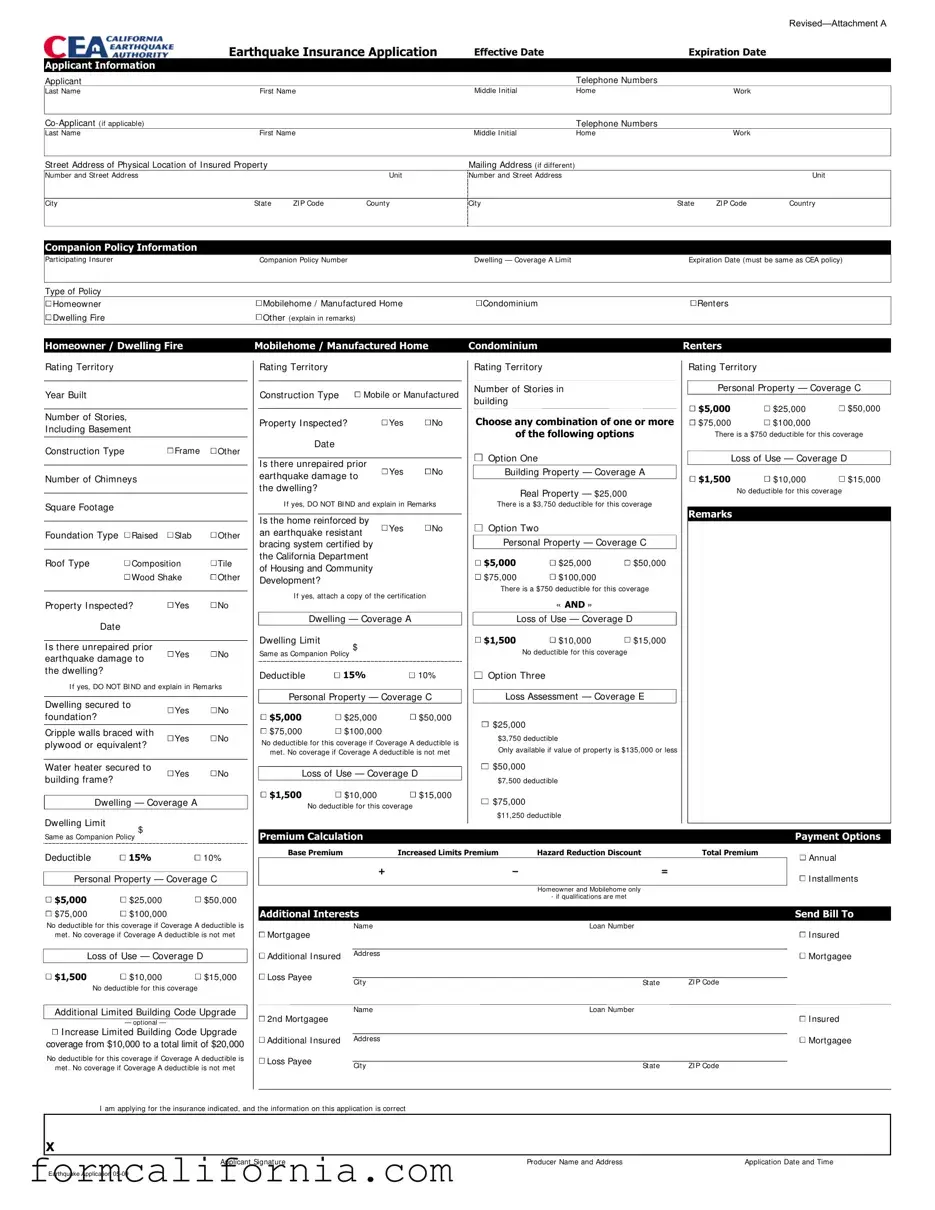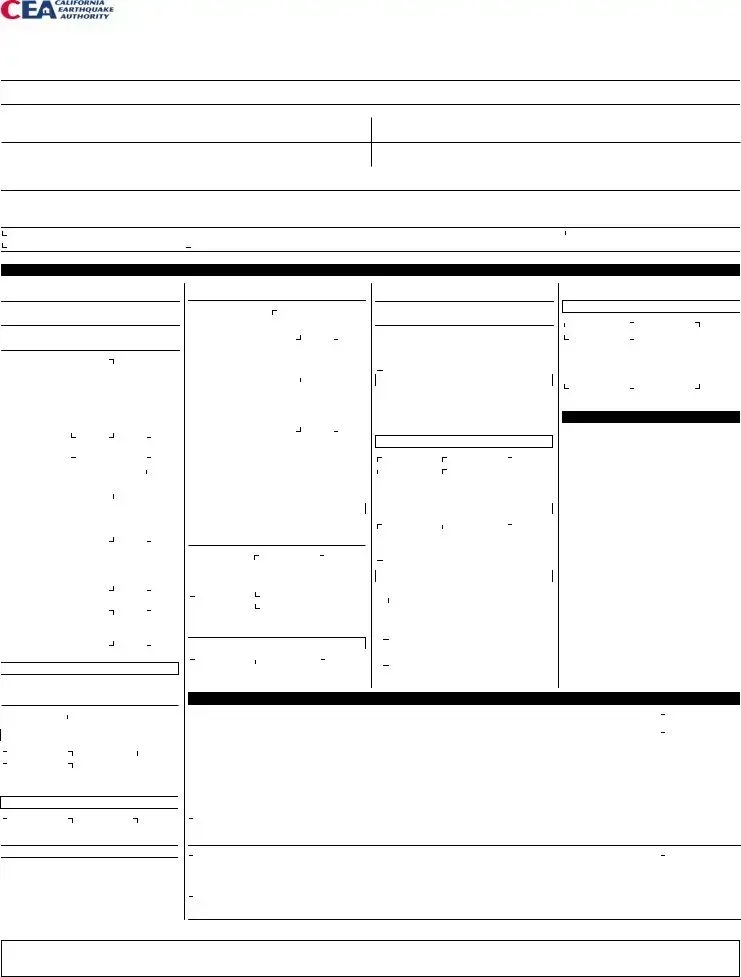Revised—Attachment A
|
Earthquake Insurance Application |
Effective Date |
|
Expiration Date |
|
Applicant Information |
|
|
|
|
|
|
|
|
Applicant |
|
|
|
|
Telephone Numbers |
|
|
|
Last Name |
First Name |
|
Middle I nitial |
Home |
|
Work |
|
Co-Applicant (if applicable) |
|
|
|
|
Telephone Numbers |
|
|
|
Last Name |
First Name |
|
Middle I nitial |
Home |
|
Work |
|
Street Address of Physical Location of I nsured Property |
|
|
Mailing Address (if different) |
|
|
|
|
Number and Street Address |
|
|
Unit |
Number and Street Address |
|
|
|
Unit |
City |
State |
ZI P Code |
County |
City |
|
State |
ZI P Code |
Country |
|
|
|
|
|
|
|
|
|
Companion Policy Information |
|
|
|
|
|
|
|
|
Participating I nsurer |
Companion Policy Number |
|
Dwelling — Coverage A Limit |
|
Expiration Date (must be same as CEA policy) |
Type of Policy |
|
|
|
|
|
|
|
|
Homeowner |
Mobilehome / Manufactured Home |
Condominium |
|
|
Renters |
|
Dwelling Fire |
Other (explain in remarks) |
|
|
|
|
|
|
Homeowner / Dwelling Fire
Mobilehome / Manufactured Home
Rating Territory
Year Built
Number of Stories,
I ncluding Basement
|
Construction Type |
|
Frame |
Other |
|
|
|
|
|
Number of Chimneys |
|
|
|
|
|
|
|
|
Square Footage |
|
|
|
|
|
|
|
|
|
Foundation Type |
Raised |
Slab |
Other |
|
|
|
|
|
Roof Type |
Composition |
Tile |
|
|
Wood Shake |
Other |
|
|
|
|
|
Property I nspected? |
Yes |
No |
|
Date |
|
|
|
|
|
|
|
|
I s there unrepaired prior |
Yes |
No |
|
earthquake damage to |
|
|
|
|
the dwelling? |
|
|
|
|
I f yes, DO NOT BI ND and explain in Remarks |
|
|
|
|
|
|
Dwelling secured to |
|
Yes |
No |
|
foundation? |
|
|
|
|
|
|
|
|
|
|
Cripple walls braced with |
Yes |
No |
|
plywood or equivalent? |
|
|
|
|
|
|
|
|
Water heater secured to |
Yes |
No |
|
building frame? |
|
|
|
|
|
|
Dwelling — Coverage A |
|
|
Dwelling Limit |
$ |
|
|
|
|
|
|
Rating Territory
|
Construction Type |
Mobile or Manufactured |
|
|
|
|
|
Property I nspected? |
Yes |
No |
|
Date |
|
|
|
|
|
|
|
|
I s there unrepaired prior |
Yes |
No |
|
earthquake damage to |
|
|
|
|
the dwelling? |
|
|
|
|
I f yes, DO NOT BI ND and explain in Remarks |
|
|
|
|
|
Is the home reinforced by |
Yes |
No |
|
an earthquake resistant |
|
|
|
|
bracing system certified by |
|
|
|
the California Department |
|
|
|
of Housing and Community |
|
|
|
Development? |
|
|
|
|
I f yes, attach a copy of the certification |
|
Dwelling — Coverage A |
|
|
Dwelling Limit |
$ |
|
|
|
|
|
|
|
Same as Companion Policy |
|
|
|
Deductible |
15% |
|
10% |
|
Personal Property — Coverage C |
|
$5,000 |
$25,000 |
|
$50,000 |
|
$75,000 |
$100,000 |
|
|
No deductible for this coverage if Coverage A deductible is met. No coverage if Coverage A deductible is not met
Loss of Use — Coverage D
$1,500 |
$10,000 |
$15,000 |
|
No deductible for this coverage |
|
Rating Territory
Number of Stories in building
Choose any combination of one or more
of the following options
Option One
Building Property — Coverage A
Real Property — $25,000
There is a $3,750 deductible for this coverage
Option Two
Personal Property — Coverage C
$5,000 |
$25,000 |
$50,000 |
$75,000 |
$100,000 |
|
There is a $750 deductible for this coverage
«AND »
Loss of Use — Coverage D
No deductible for this coverage
Option Three
Loss Assessment — Coverage E
$25,000
$3,750 deductible
Only available if value of property is $135,000 or less
$50,000
$7,500 deductible
$75,000
$11,250 deductible
Rating Territory
Personal Property — Coverage C
$5,000 |
$25,000 |
$50,000 |
$75,000 |
$100,000 |
|
There is a $750 deductible for this coverage
Loss of Use — Coverage D
$1,500 |
$10,000 |
$15,000 |
|
No deductible for this coverage |
|
Remarks
Same as Companion Policy |
|
Deductible |
15% |
10% |
Personal Property — Coverage C |
$5,000 |
$25,000 |
$50,000 |
$75,000 |
$100,000 |
|
No deductible for this coverage if Coverage A deductible is met. No coverage if Coverage A deductible is not met
Loss of Use — Coverage D
No deductible for this coverage
Additional Limited Building Code Upgrade
— optional —
 I ncrease Limited Building Code Upgrade coverage from $10,000 to a total limit of $20,000
I ncrease Limited Building Code Upgrade coverage from $10,000 to a total limit of $20,000
No deductible for this coverage if Coverage A deductible is met. No coverage if Coverage A deductible is not met
Premium Calculation |
|
|
|
Payment Options |
Base Premium |
Increased Limits Premium |
Hazard Reduction Discount |
Total Premium |
Annual |
|
|
|
|
+ |
|
− |
= |
I nstallments |
|
|
|
|
|
|
Homeowner and Mobilehome only |
|
|
|
|
- if qualifications are met |
|
|
|
Additional Interests |
|
|
Send Bill To |
|
|
Name |
Loan Number |
|
|
|
Mortgagee |
|
|
|
I nsured |
|
|
|
|
|
|
|
Additional I nsured |
Address |
|
|
Mortgagee |
|
|
|
|
|
Loss Payee |
|
|
|
|
|
City |
State |
ZI P Code |
|
|
|
|
Name |
Loan Number |
|
|
|
2nd Mortgagee |
|
|
|
I nsured |
|
|
|
|
|
|
|
Additional I nsured Address |
|
|
Mortgagee |
|
Loss Payee |
|
|
|
|
|
City |
State |
ZI P Code |
|
|
I am applying for the insurance indicated, and the information on this application is correct
X
Applicant Signature |
Producer Name and Address |
Application Date and Time |
Earthquake Application 05-09
Attachment A – Page 2
CALIFORNIA EARTHQUAKE AUTHORITY
EARTHQUAKE INSURANCE APPLICATION – 05/09 Edition
INSTRUCTIONS
POLICY EFFECTIVE DATE AND EXPIRATION DATE
Provide CEA policy effective date and expiration date. Expiration date MUST be the same as the expiration date of the companion policy.
APPLICANT
Complete all requested information for applicant(s) including: Name(s)
Telephone number(s)
Street address of physical location of insured property
Mailing address (if different from street address of property’s physical location)
COMPANION POLICY INFORMATION
Complete all requested information for companion policy including: Name of Participating Insurer
Policy number of companion policy
Dwelling limit (i.e., Coverage A) of companion policy (if companion policy has dwelling limit) Expiration date of companion policy
Type of companion policy
POLICY TYPE –RATING AND COVERAGE INFORMATION Identify CEA policy type based on the type of companion policy as follows:
•Homeowner (Companion policy must be either a Homeowners (HO-1, 2, 3, 5, or 8), Dwelling Fire (building), Landlord (building), or Mobilehome policy.)
O MOBILEHOME/MANUFACTURED HOME (Written on CEA Homeowner Policy form; however, requires unique rating information.)
Condominium (i.e. Common Interest Development) (Companion policy must be a Condominium Unit Owners (HO-6) policy.)
Renters (Companion policy must be a Renters (HO-4) , Mobilehome (tenant policy), Dwelling Fire (contents only), or Landlord (contents only) policy.)
Complete all information requested under the applicable CEA policy type. Answer all questions and select desired CEA policy limits and coverage options.
PREMIUM CALCULATION
Provide premium calculations.
PAYMENT OPTIONS
Select payment option:
Annual; or
Installments
SEND BILL TO
Select who should receive the bill:
Insured; or
Mortgagee
ADDITIONAL INTERESTS
Complete information requested for each additional interest, including:
Type:
OMortgagee;
OAdditional insured; or
OLoss payee
Name and address
Loan number (if applicable)
REMARKS
Include any additional remarks as needed.
SIGNATURE
Secure the applicant’s signature on the application.
Provide the producer’s name and address.
Provide the date and time the application is completed.


 I ncrease Limited Building Code Upgrade coverage from $10,000 to a total limit of $20,000
I ncrease Limited Building Code Upgrade coverage from $10,000 to a total limit of $20,000